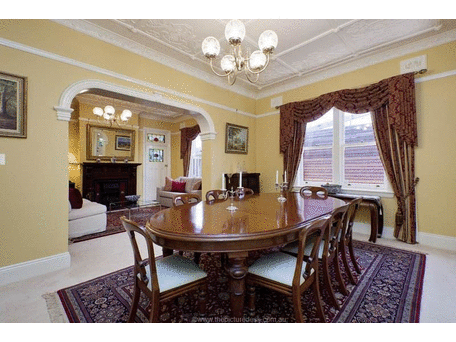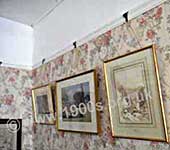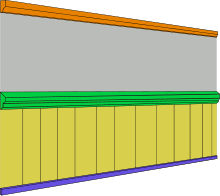Desirable features of Federation home design
[Previous page: Federation Paint Colours ... Next page: ]

Table of Contents

- lofty, decorative ceilings,
- art nouveau lead-light glass
- picture rails,
- bay windows
- ornate fireplaces
- arched fretwork,
- decorative verandahs;
to which we can add a secondary wish-list of: - timber floorboards
- tall chimneys,
- tiled verandahs and
- tiled front paths
High ceilings

Are ceiling heights important? Most people would agree that they are very important, for a variety of reasons:
- Generally, most marketing campaigns for houses (for sale) will highlight tall ceilingsand for good reason:
quite simply, the rooms are more spacious and feel better. Tall ceiling heights are nearly always found in old period or high-quality contemporary homes.[1] - A quick and easy test (for most people of average height) to ascertain ceiling heights when walking through a home is to simply raise your arm straight above you.
If you can (or almost can) touch the ceiling, then the ceiling heights are probably about 2.4 metres. In living areas and bedrooms, most people will not like this as it is just too low. As a rule, 2.7m is OK and 3m or higher is best.
 |  | |
| 29 Grandview Street, Pymble, NSW | 52 Middle Harbour Road LINDFIELD |
Advantages of high ceilings
Air
Heritage homes needed high ceilings because the height provides a place for hot air to rise, so high ceilings allow more air circulation and make the home easier to cool in warmer weather.
The Bungalow designed by J. Burcham Clamp and Walter Burley Griffin with exquisite leadlighting - Rooms heated by fireplaces in winter were smoky and high ceilings allowed smoke wisps to escape above the inhabitants
"The underlying themes of buildings and interior design of the Edwardian era were for expensive simplicity and sunshine and air....The desire for cleanliness continues....
As gas and then electric light became more widespread, walls could be lighter as they did not get so dirty and looked better in the brighter light."[2] (They needed higher ceilings in the days before electricity because the ceiling lights were candles and you didn't want the ceiling catching fire or turning black too fast from the soot.) * Transom windows that open near the ceiling and 'fanlight' windows above doorways allow seasonal hot or smoky air to escape;
* Transom windows that open near the ceiling and 'fanlight' windows above doorways allow seasonal hot or smoky air to escape;
* Tall ceilings allowed the installation of breezeway and ceiling ventilation fretwork in Art Nouveau designs
* Timber arches were popular to compartmentalise interiors while aiding cross-ventilation. Grandeur
Space! A high ceiling within the main living areas provides a sense of grandeur upon entering the home: a high ceiling gives the feeling of elegance and spacious luxury
A grand space with towering ceiling heights allows us to create a focal point with a prominent decorative lighting feature.
* Ceiling heights should be varied to accommodate the room purpose and room size: the larger the room, the higher the ceiling. * The ceiling height opens up the living space and creates a welcoming atmosphere;
* The ceiling height opens up the living space and creates a welcoming atmosphere;
* High ceilings create a light and airy space that makes a room look bigger than it really is
Light
"Although electric wiring was universal by the 1890s, incandescent lighting remained weak and inefficient… Natural light was the most important factor in setting the dimensions of the (room), because until the introduction of fluorescent lighting in the 1940s, sunlight was the principal source of illumination for interiors."[3]
Sky-high ceilings can make way for plenty of glass. High ceilings allow higher windows which let the sun shine in - more opportunities for light via highlight windows.If a home faces North, this can be a wondrous thing: warm in winter, cool in summer – a room like this is the place to be.
Federation Ceilings are White Ceilings
With universal electrification after 1913 early Edwardian and Federation homes had gas light downstairs.- Ceilings changed from highly decorated and coloured to white ceilings ornamented with plaster cornices, ceiling roses and panels, many of them moulded by skilled plasterers. White ceilings bring light into the room and create the airy cleanliness possible without burning gas.
I love ornate ceilings. Look up! Forget flat ceilings. Here the texture creates interest and opens up the room.
 |
| 32 Provincial Road Lindfield NSW |

The previous Victorian patterned papers or stencil decorations became panels manufactured from sheet zinc or steel, with impressed decorative patterns stamped into them.
- This jeopardised the livelihood of the plaster craftsmen who, during the Federation era, grew to produce very fine decorative relief work in their plaster cornices and ceiling roses.
- The fine relief plaster was common in homes for the elite (as in the past) and also become more common in the average country cottage.
- A patriotic feeling that swept the Federation era inspired many designs of flannel flowers, gum blossoms and waratahs.
 |
| Wunderlich factory 1895- making pressed metal ceilings |
Picture rails
 |
| Victorian wall showing, from the bottom, dado, dado rail, wallpaper, picture rail and at the top, a frieze. |
In many nineteenth century and Federation houses there were usually one or two wooden rails.
- The upper rail was used either to hang framed pictures from or to place picture frames within a space made between the ceiling and the dado, rather like a small exhibition space along the top of a room.
- The picture rail would be situated level with the top of the door frame.
- Originating in the 15th century, picture rails peaked in popularity in the late 19th century, when it was fashionable to have rooms full of hanging pictures and knick-knacks.
- Often during this period, the picture rail would be nearly invisible, buried beneath a solid line of portraits and paintings lining the walls.
- The rail provides a way to hang pictures instantly, without putting holes in the walls.

- The hanging itself it accomplished by an accessory called a “picture rail hook,” usually made of metal, which has an arm that hangs over the top of the rail. A second arm extends down in front of the rail to provide a hook to hang the picture.
- Victorian and so Federation picture rails were functional, and accordingly, stuck out further from the wall to allow ample room for hooks.[4]
The (lower) dado rail was usually placed at chair height. This was a common practice in the eighteenth century when chairs, particularly in dining rooms, were not placed around a table when not in use, but placed against a wall. To stop the chairs damaging the sometimes expensive wallpaper or paintings, a wooden dado rail was used.
 |
| Crown moulding (top), dado rail (middle) and the skirting board (lower). |
- A dado rail, also known as a chair rail, is a type of moulding fixed horizontally to the wall around the perimeter of a room.
 |
| Victorian interior with a dado rail and dado beneath |
- Traditionally, the height of the dado rail is around 36" or 900 mm, which was a suitable height to protect the wall from the backs of chairs. Since the original purpose of the dado treatment is not applicable in modern homes, it is now common to see dado rails at 1200 mm or even 1500 mm from the floor.
Dados
- A dado is the lower portion of the wall of a room, and is decorated differently from the upper section, using panels.
Because Federation homes were built with double brick walls, rising damp was not a problem, and the dado disappeared after the turn of the twentieth century.
Bay Windows
Bay windows became a hugely popular feature of residential Victorian architecture in the British Isles from about the 1870s and hold a continuous appeal up to this day.
- Bay windows are used to increase the flow of natural light into a building, thereby also making a room appear larger, and
- bay windows provide views of the outside which would be unavailable with an ordinary flat window.
- Based on British models, their use spread to other English speaking countries like the USA, Canada and Australia.
- Bay windows were identified as a defining characteristic of San Francisco architecture in a 2012 study that had a machine learningalgorithm examine a random sample of 25,000 photos of cities from Google Street View.[3]
Federation Fireplaces
A Federation fireplace comes from an interesting period of history, when industrialization and craftsmanship merged for a moment and created affordable yet well-made pieces for the home.Before electric heating, fireplaces would be placed in the kitchen, bedroom, living room and other rooms in the house requiring heat.
- Over time, fireplaces became the focal point of rooms, acting as gathering places for family and visitors. As such, fireplaces took on an increasingly decorative character, peaking in the French Rococo and Victorian eras. The largest fireplace mantels could extend across the wall of a room, showcasing the ornate carvings and figures put into the facade of the fireplace.
| An Edwardian Fireplace with dado rail |
- A modern fireplace usually serves as an element to enhance the grandeur of an interior space rather than as a heat source.
The Edwardian era embraced lighter patterns, brighter colours and simpler designs.
- At the same time, the Edwardian period saw a strong interest in reviving historical styles, like neo-Classicism.
- The period also embraced the Art Nouveau, Art Deco and Arts and Crafts styles.
- All of these decorative styles can be found in antique Federation fireplaces.
- Since this was one of the last periods of hand-made, skilled craftsmanship before industrialisation became widespread, fireplaces made in Federation times hold an interesting place in the history of fireplaces.
- A Federation fireplace is a great combination of style and function with a more subdued aesthetic than Victorian or Rococo fireplaces.
- Tiled panels were popular in this period and add an exciting splash of colour to a Federation fireplace.[5]

Typical Features of a Federation Fireplace
Cast iron insert or combination fireplace
Like most antique fireplaces, the Federation fireplace usually has a cast iron insert or is a completely cast iron combination fireplace. Cast iron is poured into a mould to create the desired shape, and is very durable.- Decorative elements
An Edwardian fireplace will usually have some decorative elements on the surround, mantel or on the fireplace insert. - Tiles
Tiled panels or sets of tiles were a common feature in Edwardian fireplaces. They can add a customizable colour and style to a fireplace and are often highly coveted by collectors.
Home is where the hearth is
Date June 22, 2013 David AdamsStructure and safety must be considered when restoring a fireplace to its former glory.
- ''If it's a Federation or Victorian house, really, you should put back the cast-iron insert and then the right surround for the era,'' she says. ''Even if you're doing a modern renovation, it's still a good idea to put that insert in, put a very plain surround around it, and just paint it white or something.''
- Austin advises against using what was once a fireplace for any other purpose - such as a bookcase, for example.
- ''I think in a bedroom or a sitting room, the only option really is to reinstate the fireplace. Otherwise, the room just doesn't look right.''
While buying a new surround and insert is an option, Austin says home owners may also want to consider second-hand parts.
 |
| Federation Style Fireplace with gas insert |
''Sometimes it's nice to go to Steptoe's [Renovation Supplies in Collingwood] or somewhere and get an old marble one for a Victorian house or an old timber one for a Federation house.''
- Steve Peroukaneas, fireplace co-ordinator at Schots Home Emporium, says new fireplace mantels and inserts start about $1200 to $1300. Gas burners, which fit into an insert and heat up to three square metres, are similarly priced.
- ''There is a fan-forced open gas unit which will suit period [homes] - Edwardian, Federation, or whatever - and the [price] will go up to about $3000,'' he says.
- These can be installed in a room where there is no existing chimney, good news for buildings where chimneys may have been removed. ''You can build a chimney breast and run a flue system inside the cavity,'' Mr Peroukaneas says. ''Nobody would know - it looks authentic …''
- Glenn Bradbury, of Lifestyle Fireplaces, says the cost of fireplace restoration varies immensely.
- ''Every job's different. It depends on what the customer actually requires, the type of insert they want installed; do they want the hearth all replaced? Do they want gas or solid fuel burning, or do they just want it to be decorative?'' he says.
Mr Bradbury says he rarely installs purely decorative fireplaces. For those who want the charm of a fireplace but don't want to burn gas or solid fuel, Mr Bradbury says an ethanol burner (prices start about $900) may be an option.
- ''They just let off water vapour when they burn,'' he says. ''They provide a few hours of warmth and decoration at a time.''
Mr Bradbury says home owners contemplating restoring a fireplace to a functional feature need to be sure the chimney is in good order.
- A chimney in a poor state can lead to house fires, Mr Bradbury warns.
- ''If there's an existing fireplace, just make sure it's safe to use. If householders are not sure, they can get someone like us to come in and, for a fee, we'll inspect the chimney and make sure it is safe to use.''
- And, of course, any work on a fireplace needs to comply with the building code.
Mr Bradbury's final word of advice?
- ''Spend a little extra and get it looking right,'' he says.
- ''When people walk into a home, especially a period-style home, they want to see the fireplace and, whether it's working or not, it's got to look right.''[6]
Austin Design Associates: austindesign.com.au
Schots Home Emporium: schots.com.au
Lifestyle Fireplaces: lifestylefireplaces.com.au
Fretwork Arches

from http://www.woodworkers.com.au/
Styles of Arches
Timber arches were traditionally used to- provide visual accents to long passages,
- divide larger rooms or
- define the family areas from the rooms used by visitors.
 |
| Grand foliage pedestal arch frames an Alisterbrae bay window |
Arches are generally in one of three styles:
1. Georgian
Georgian archways generally pre-date the turn of the 20th Century and were simple timber reconstructions of classical masonry arches.2. Federation/Bungalow
Federation style archways are typically vertical timber slats within a curved frame, progressively becoming simpler, straighter and more angular as the Californian Bungalow influence was felt.
3. Art Nouveau.
Art Nouveau arches were popular in the Edwardian period and typically involved elaborate curvilinear fretworks and asymmetrical designs.Arch Installation
Archway openings were traditionally formed exactly the same as doorway openings.- They were lined with jambs and had architraves fitted both sides.
- They were usually constructed the same height as all other openings to a height of approx 2550mm.
- The arches themselves were then simply skew nailed into position. These days "no more nails" adhesive is more common but the positioning and lining details should be duplicated for the best result.
For wider openings the arch is split in the centre and an extension piece is added to the width required.

- The joints are covered by the keyblocks.
- There are a range of extensions piece designs available to individualize the arch or match other details pre existing in the house.
 |
| Art Nouveau fretwork arch in 44 Arthur Street RANDWICK NSW |
| Impressive Fanlight fretwork around the staircase and spandrels beneath the bench seating at 87 Avoca Street RANDWICK |
Fretwork Spandrels
1. The roughly triangular space between the left or right exterior curve of an arch and the rectangular framework surrounding it.2. The space between two arches and a horizontal molding or cornice above them.
| Impressive fretwork spandrels frame the front entrance at 87 Avoca Street RANDWICK |
- ^ http://marketnews.com.au/2010/03/house-ceiling-heights-high-or-low/
- ^ http://www.housepursuits.co.uk/architectural.html
- ^ http://www.metropolitanwalks.com/blog/why-old-buildings-have-such-high-ceilings/
- ^ http://www.wisegeek.com/what-is-a-picture-rail.htm
- ^ http://www.ebay.com.au/gds/Your-Guide-to-Buying-an-Edwardian-Fireplace-/10000000177317466/g.html
- ^ http://news.domain.com.au/domain/real-estate-news/home-is-where-the-hearth-is-20130620-2ojul.html

No comments:
Post a Comment